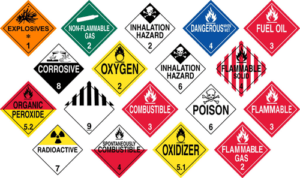On May 11, 1996, ValuJet Flight 592 crashed in the Florida Everglades, killing all 110 passengers and crew just 10 minutes after take-off from Miami, Florida. The National Transportation Safety Board (NTSB), determined that the probable cause of the accident which resulted in a fire in the airplane’s class D cargo compartment, was initiated by actuation of one or more oxygen generators that were improperly packaged as cargo.
On the morning of October 28, 1998, 2 gallons of a 35-percent hydrogen peroxide solution in water, an oxidiser with corrosive properties, spilled in a cargo compartment of Northwest Airlines (Northwest) flight 957, a passenger-carrying airplane en route from Orlando, Florida, to Memphis, Tennessee. The solution leaked from two undeclared 1-gallon plastic bottles that had spilled. The bottles were in an ice chest that belonged to a passenger on the flight. The leaking hydrogen peroxide contaminated three mail sacks and bags. The leak was not discovered until cargo handlers in Memphis began to unload the baggage on flight 957.
The handlers assumed that the spilled liquid was water, ignored it and transferred some of the baggage to other Northwest passenger-carrying flights, including flight 7, which then departed for Seattle, Washington. On arrival in Seattle, two bags in a cargo compartment were smoldering, including one that had come from flight 957. As a result of the spill, several people who were exposed to the fumes and spillage required treatment.
Even though no serious injuries were recorded, Northwest estimated that the total cost of the damage to baggage and the downtime on the aircraft was more than US$40,000. The NTSB determined that the probable cause of the release of undeclared hazardous material aboard Northwest Airlines flight 957 was the passenger’s failure to properly package and identify the hazardous material and inadequate inquiries from the Northwest Airlines agent about the contents of the cooler offered by the passenger. Contributing to the consequences of the release were inadequate carrier procedures which allowed contaminated baggage to be transferred to other aircraft.
April 28, 1999; Northwest Airlines, Flight 0026. A fire destroyed freight which included lithium batteries on two (2) aircraft cargo pallets at the Northwest Airlines Cargo facility at Los Angeles International Airport. The pallets had been taken off an inbound passenger-carrying flight from Osaka, Japan. The probable cause was as a result of damaged lithium batteries. The NTSB’s investigation of this incident revealed that lithium batteries present a serious fire hazard to air transportation and this required immediate attention.
These and many more aviation accidents/incidents recorded have been as a result of non-declaration, poor handling, etc. of Dangerous Goods (DG).
According to the U.S. Bureau of Transportation Statistics, from 2015 – 2019, there were 6,601 hazardous material incidents on aircraft in the U.S alone, and 37 of them were accident-related. Over the years, there have been several high-profile accidents of both cargo and passenger aircraft caused by dangerous goods.
What are Dangerous Goods?
Dangerous Goods are articles or substances which can pose a hazard to health, safety, property or the environment, and which are shown in the list of dangerous goods in the International Civil Aviation Organisation (ICAO) Annex 18, the Technical Instructions for Safe Transportation of Dangerous Goods by Air and International Air Transport Association (IATA) dangerous goods regulations manual or classified according to the same regulations.
By definition, Dangerous Goods accident is an occurrence associated with and related to the transport of Dangerous Goods by air which results in fatal or serious injury to a person or major property damage.
Dangerous goods are carried regularly and routinely by air all over the world. To ensure that they do not put an aircraft and its occupants at risk, there are International Standards that each State, under the provisions of the Chicago Convention, is required to introduce into national legislation. This system ensures governmental control over the carriage of dangerous goods by air, and gives worldwide harmonisation of Safety Standards.
ICAO has come up with an Annex (specifically Annex 18) to the Chicago Convention that governs the Transportation of Dangerous Goods by air. These are International Standards and Recommended Practices from which a state develops its own regulations. In Ghana, we have the Ghana Civil Aviation (Flight Standard) Directives, Part 18, which governs the Transportation of Dangerous Goods in and out of Ghana.
In addition, ICAO also has a technical document, DOC 9284; Technical Instructions for the safe Transport of Dangerous Goods by Air. The detailed content of the Technical Instructions gives all the necessary provisions to enable a consignment of Dangerous Goods to be correctly prepared for air transport.
The IATA Dangerous Goods Regulations, published annually by IATA and based on the requirement of Annex 18 and the associated ICAO Technical Instructions, is a commercial field document for practical references by the industry.
As indicated in the preface of the IATA Dangerous Goods Regulations, Annex 18 of the Chicago Convention and ICAO DOC 9284 are the only authentic legal source material in the air transport of Dangerous Goods.
Classes of DGs
There are nine (9) classes of dangerous goods. Any substance that falls under any of the nine (9) classes of dangerous goods needs to be declared for necessary checks, proper package and stowage/storage of the dangerous goods;
- Class 1 — Explosives
- Class 2 — Gases
- Class 3 — Flammable liquids
- Class 4 — Flammable solids; substances liable to spontaneous combustion; substances which, when in contact with water, emit flammable gases
- Class 5 — Oxidising substances and organic peroxides
- Class 6 — Toxic and infectious substances
- Class 7 — Radioactive material
- Class 8 — Corrosives
- Class 9 — Miscellaneous dangerous substances and articles, including environmentally hazardous substances
Some examples of dangerous goods are aerosols, lithium batteries, infectious substances, fireworks, dry-ice, gasoline powered engines and machinery, lighters, matches, alcoholic beverages, e-cigarette, hair curlers containing hydrocarbon gas and paint.
Below are labels used to identify Dangerous Goods.
Why declare your dangerous goods (DG)?
- You need to declare your DG because there are DGs that can only go on a cargo aircraft, those that can only go on a passenger aircraft and those that can go on both passenger and cargo aircraft.
- The nature, quantity, shipment type (radioactive/non-radioactive) and type of package can determine the type of aircraft the DG can go on.
- There are DGs that can be permitted in or as checked baggage and others permitted in or as carry-on baggage.
- There are DGs that are forbidden under every circumstance to be carried by air and those that are forbidden but can be carried only under exemption when some specific safety measures are met.
- There are Dangerous Goods that are to be transported in limited quantity when going on a passenger aircraft. Some, even in excepted quantity.
- To avoid delays at the airport when travelling, and cancellation of your trip due to investigations which could lead to additional cost.
Information to passengers
Operators must inform passengers about DGs that are not permitted for passengers to carry aboard an aircraft. This information must be provided to passengers at the point of ticket purchase or, if this is not practical, made available in another manner to passengers prior to boarding pass issuance, and at boarding pass issuance, when boarding pass is issued, or prior to boarding the aircraft.
Hidden Dangerous Goods
Operators’ acceptance staff must be trained efficiently to detect and identify Dangerous Goods that are hidden in or as general cargo/goods.
Cargo declared under a general description may contain hazardous articles that are not visible. With the purpose of preventing undeclared dangerous goods from being loaded on an aircraft, and passengers from taking on board those dangerous goods which they are not permitted to have in their baggage, cargo and acceptance staff must always verify from shippers and passengers about the contents of any item of cargo or baggage where there are suspicions of it containing dangerous goods.
Below are examples of sign post of “Have you declared it?”
If all necessary measures concerning the transportation of Dangerous Goods are not taken, it can lead to serious incident/accident.
Always declare your Dangerous Goods to your ticketing agent, check-in agent or the ground handling agent. Let’s keep the air safe for flight and save lives.
Alice is a member of AVSIAG













